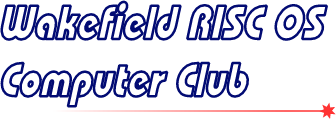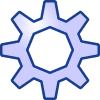Meeting: Sine Nomine Software
Matthew Phillips from Sine Nomine Software visited us to talk about some of their products and demonstrate them running on a Beagleboard. He started by looking at the facilities offered by DrawPrint for getting drawfiles on to paper, then moved on to the Impact relational database and the ways in which it can be used to store and manipulate data. Afterwards he looked at the number games offered by SuperDoku and Wrangler, as well as the many patience games played by House of Cards. The evening ended with a quick overview of the machine on which the demo was carried out.
Report by Rick Sterry
The June meeting featured the very first visit to the club of Matthew Phillips from Sine Nomine Software, though of course he and Hilary (the other half of Sine Nomine) exhibited at our recent RISC OS Show. They had previously been based in Dundee, which is a bit far to travel to Wakefield just for an evening. However, they now live in Durham, and so Matthew was able to come by train, with Steve Fryatt serving as taxi driver from the station. Matthew was using a Beagleboard, which considerably reduced the burden he had to carry (literally).
The Beagleboard has only an HDMI video output, so the Club has bought a clever little box that takes in HDMI and gives out VGA to suit our video projector – this was a far cheaper option than replacing the projector. One snag we discovered was that the new box does not have an HDMI output to feed to the local monitor, so a VGA output from the projector had to be used instead, which caused a slight problem with us not being able to display the whole screen area – a conflict between the different screen aspect ratios I suspect. Some thought will be given to this prior to the next occasion when HDMI will be required, probably in September when we (provisionally) have R-Comp showing the new ARMini.
Printing drawfiles
Matthew started out by talking about DrawPrint, which allows you to print a drawfile over several pages at the scale of your choice. You can also print sprites or JPEGs by wrapping them up in a drawfile first, but now this process has been automated to make it quicker and easier. DrawPrint is now used for printing tables from LuaFox and from Impact.
Next came a demo of the Impact relational database. This was originally developed by John Skingley of Circle Software, then transferred to CJE Micros in 2003 but developed further by Matthew and Hilary on CJE’s behalf until 2008 when they took it over completely. Databases are undoubtedly very useful and powerful pieces of software, although not necessarily the most exciting to demonstrate, but Matthew’s infectious enthusiasm proved that this does not have to be the case. He is extremely keen to continue to develop the features in response to user feedback, but has been a little frustrated by the lack of it via the user forum. He emphasised how useful it is to meet users face-to-face at the shows, as he does then receive some very helpful feedback and suggestions for enhancements. He listed some interesting uses for Impact, some more obvious than others, the strangest of which was complex route planning for continental driving tours. Even Matthew couldn’t work out how on earth that particular user made the program do this!
Making an impact
Impact is one of a very few RISC OS applications to support the ‘Drag and Drop’ protocol (part of it at any rate), so that when exporting data a ‘ghost’ caret appears in the receiving document for you to position where you wish to drop the data, provided that the other application also supports the protocol. The best known applications to support this protocol are EasiWriter and TechWriter, which were originally produced by Icon Technology but are now in the extremely capable hands of Martin Würthner of ArtWorks 2 fame. However, it is also supported by Messenger Pro’s editor, a fact that many users may not be aware of. One rather nice feature of Impact is the support of the command ‘url’ in the scripting language, which can launch not just static URLs but ones based on the record data. As we had internet access available, Matthew demonstrated how clicking on a record field could launch a ‘mailto:’ link in order to send an email to someone in the database, or launch www.streetmap.co.uk to show a map when a postcode is clicked on, or launch www.transportdirect.info and show how to travel to that postcode. The latest revision of Impact dates from April of this year, and among many enhancements there is the ability to export a table as a drawfile.
Bundled with Impact is LabPrint, a comprehensive label printing program which interacts seamlessly with Impact. Even the demo version of Impact comes with the full version of LabPrint, should you wish to use it as a stand-alone application by dropping CSV files onto it. (LabPrint does not have its own separate user manual, but is described in the Impact manual.)
We then had a short break for Matthew to quench his thirst and chat to interested members about the Beagleboard, which looked almost comically tiny in its clear Perspex case – it was considerably smaller than the HDMI-VGA converter box, and only about the same volume as the miniature USB hard drive it was being used with!
Games and puzzles
Matthew then moved on to more light-hearted software, starting with Wrangler, which is a general mathematical puzzle generator and solver currently supporting Kakuro, Cross Sums and Shikaku, though Hilary is keen to add other puzzle types in the future. You can solve these the hard way, i.e. on your own, or with displayed hints, or you can simply let the program solve the puzzle for you! After this, Matthew briefly demonstrated Wrangler’s close cousin, SuperDoku, the use of which must be seventh heaven for Sudoku fans. It has many options and features, including (like Wrangler) the ability to export puzzles as drawfiles for printing out hard copies for solving away from the computer, using Draw, DrawPrint or a DTP package. Even though I am completely hopeless at mathematical puzzles, I almost wanted to buy Wrangler and SuperDoku, thanks to Matthew’s enthusiastic delivery, combined with some very nice user-friendly features in the software itself.
Next came House of Cards, which is a suite of 44 Patience games (so far), with many very clever advanced features. It has far too many to mention here, but the latest addition is the ability to save interrupted games for resumption later. The individual games are written in the Lua scripting language, but House of Cards can also import game scripts from SPatience – it even works out the rules from the SPatience scripts and displays them for you. Though I am a useless card player I was almost carried away by Matthew’s presentation. It clearly comes across that developing software is a labour of love for both Matthew and Hilary, and this shines through in the end products. I should add that DrawPrint, Wrangler, SuperDoku and House of Cards are all written by Hilary.
Finally, Matthew described the fun and games that he had experienced when installing Ubuntu on the Beagleboard. This is far from straightforward as you need access to another Linux machine – it’s a bit chicken-and-eggy. It would be much easier for the average user if SD cards and hard drives were available for the Beagleboard with RISC OS and Ubuntu both ready set up.
Matthew thanked the Club for organising the recent show, and extended the show discount to allow for anyone having been too busy to buy on the day – a few members availed themselves of this opportunity. He proved himself to be a very lively, enthusiastic, informative and entertaining speaker, and his presentation was clearly well received by an appreciative audience.
More information
Details of Sine Nomine’s software, along with the option of online purchase, can be found at www.sinenomine.co.uk/software







